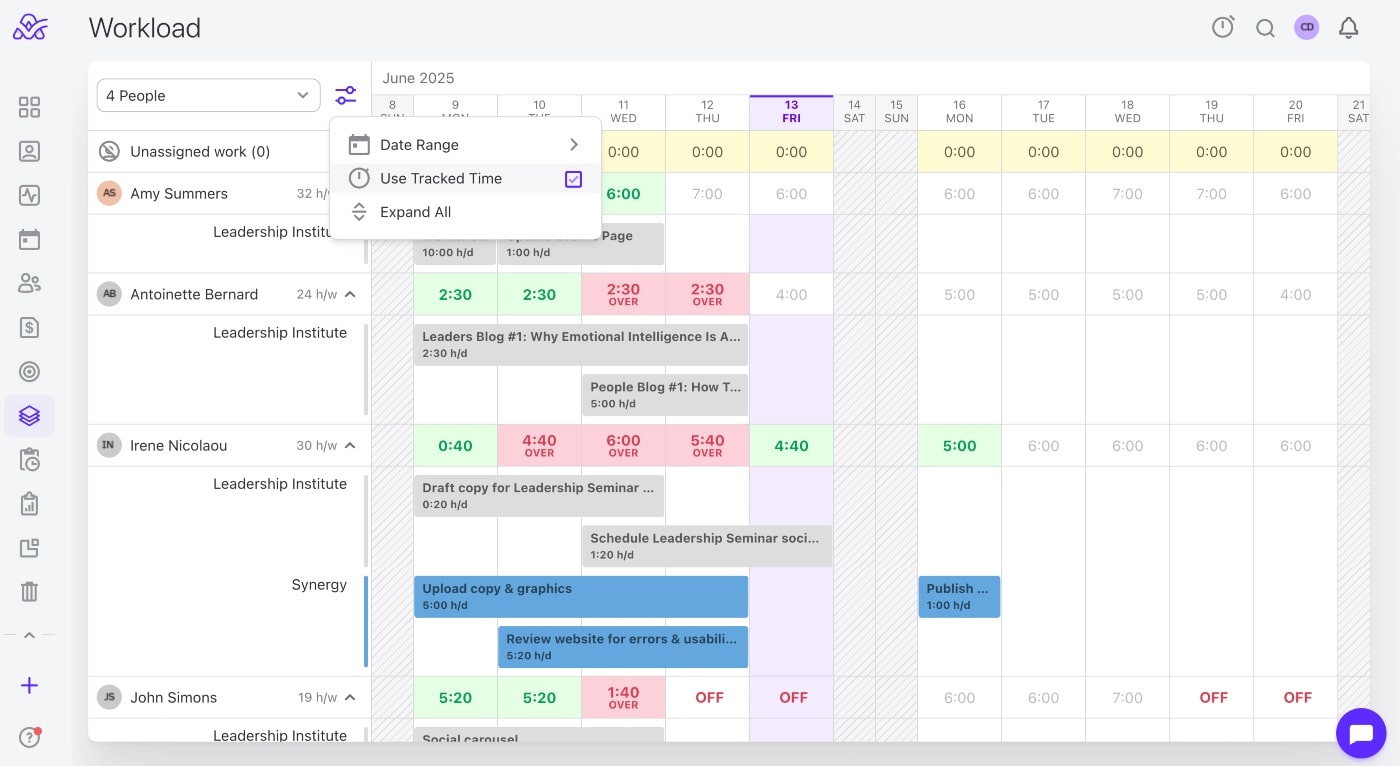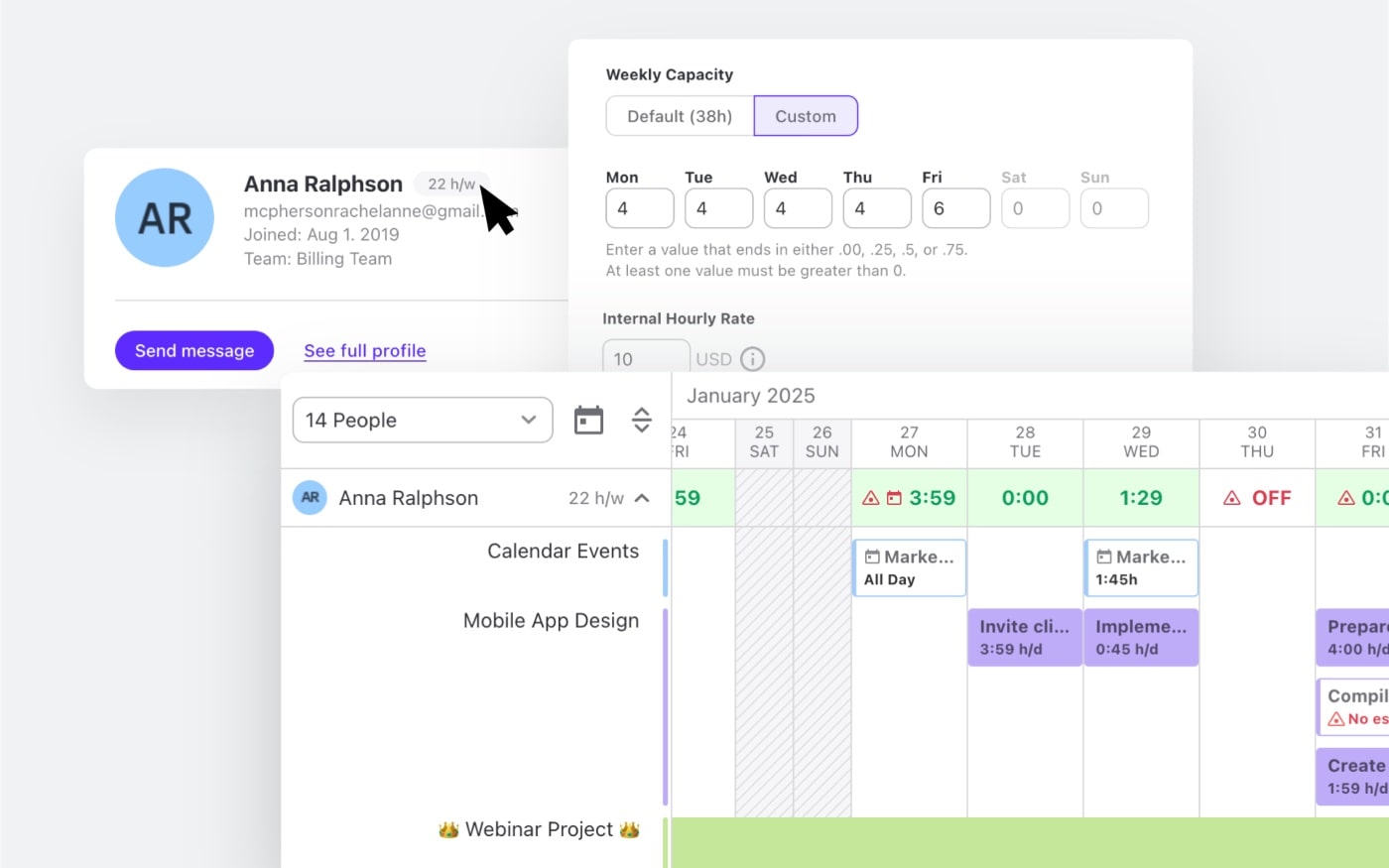Prevent burnout, manage bottlenecks, avoid burning client bridges, and ensure you can take on more business without pushing your entire team to collapse. These are all the things top-notch capacity planning strategies will do for you.
If a sustainable agency or consultancy is what you're aiming for, then you need a strategy and a capacity planning process. But be warned: it’s not a one-size-fits-all matter. To make your strategic capacity planning work for you, it needs to align with your business type, size, and maturity level.
That’s why we’re unpacking the four types of capacity planning strategies. We tell you what they are, explain the purposes they serve, and reveal the key giveaways that determine if it’s the right capacity strategy for your business. Because choosing the wrong one could lead to more trouble than triumph (and nobody wants that!)
Lag strategy

The lag strategy involves waiting for actual demand within your business to exceed your current resource capacity before hiring new people.
This is a good strategy to apply when costs need to be contained or market demand is not particularly high. It’s a conservative approach. One where you avoid excess capacity, plan and cater for your current workload only, and ignore potential future customer demand.
Most small to mid-sized service businesses turn to this type of capacity planning process because it pushes them to utilize the existing workforce and production capacity fully. They wait to see a 100% resource utilization or a consistent trend of overcapacity (or even lost business opportunities) before they switch to other capacity planning strategies.
When to use the lag strategy
- When operational efficiency is key – This is usually the case for startups and early-stage businesses that are cash-conscious and those that want to want to minimize overheads through rigorous cost management.
- When customer demand is unpredictable – This is often the case when you don’t have any previous historical data, or when it’s difficult to land accurate sales forecasts.
- When fluctuation is the norm – If your service industry is one where the anticipated demand is in constant fluctuation is the norm.
When not to use the lag strategy
- When scaling your professional services business – When your goal is increasing production capacity or growing client portfolios, you’ll need to have the workforce on hand and ready to go.
- When team burnout is likely – If resource utilization is exceeding current capacity, you risk losing the employees you already have, and pushing further for future demand creates a business risk.
- When talent is scarce – This might be rare, but if a particular role is generally hard to find when you need it, you might not want to wait until the last minute.
So, the lag approach is one of the key capacity planning strategies for service businesses that want to meet customer demand, but also stay lean.

Lead strategy
Lead strategy is when you plan capacity in line with future forecast demand. It’s the complete opposite of the lag capacity planning strategy method because your resource capacity planning focuses on having more people (excess capacity) than you may currently need to meet demand.
If you’re predicting future demand growth or are looking to grow your business (you might be investing in marketing and expecting a spike in clients or projects), this capacity planning process is the method you’d use. In some cases, because lead capacity planning takes a proactive approach to workforce capacity planning, it can also be seen as a more aggressive strategy because it prepares you for work you don’t have yet.
It’s the right choice for scaling businesses and project managers expecting increased demand and those with their eyes on the future. It prepares your team for work that is yet to arrive, but is expected (if based on accurate demand forecasting).
When to use the lead strategy
- When the forecast is growth and high market demand – The lead capacity planning process is best if you have a steady stream of customer demand and incoming business.
- When expanding your business – Whether you’re launching a new vertical or expanding to a new region, you’ll want to be fully prepared to meet market demand.
- If you don’t want to decline projects – In highly competitive industries, this is a big thing. This kind of resource planning focuses on having enough people to accept every project.
When not to use the lead strategy
- When training & onboarding are issues – If you don’t have efficient onboarding in place, this could end up being a hidden cost you didn’t anticipate.
- When your budget is limited – You need to be able to withstand the cost and time it takes to see new hires reflected in revenue growth.
- Flimsy or unreliable forecast data – You’ll need to make sure your forecast data is accurate. Hiring in advance can inflate your costs and cut margins.
So the lead strategy is one of the capacity planning strategies businesses turn to when they want to be ready to seize high-value opportunities with confidence, without worrying about unmanageable workloads. But it needs solid financial backing.

Match strategy
The match strategy is a flexible and dynamic approach. It involves regularly and simultaneously monitoring your business demand and the team’s capacity so you can match them up as much as possible. It’s a more time-consuming method that keeps on top of changes and aims to address them quickly.
Combining cost effectiveness and growth potential, this is a relatively safe and agile approach to capacity planning. However, it’s a little complex in practice, and you need some level of data to inform your decisions.
It usually involves including flexible staffing options in your recruitment processes and business operations. This means you’ll need to be prepared to adopt a hybrid business model. By leveraging external providers who can jump onto project tasks quickly when demand spikes, you minimize the overhead costs associated with full-timers.
When to use the match strategy
- When you’re a mature business – You have a stable cash flow and access to reliable business forecasting data.
- When you have integrated tools – You can monitor and match capacity to demand because you use an integrated productivity tool like ActiveCollab to manage and track time on client tasks.
- When a hybrid team is your vibe – If you like using a combination of full-time and part-time employees, and mix it up with freelancers or contractors.
When not to use the match strategy
- When your data is not real-time – If you’re managing your team and projects in spreadsheets and doing manual reports, it will be overwhelming and confusing.
- When your operations are clunky – If you don’t have the right systems and processes in place, it’s difficult to maintain and practice effectively.
- When you’re not fully committed – If you’re not prepared to commit, or don’t have a dedicated person owning and leading the planning project.
So, the match strategy is one of the capacity planning strategies business leaders apply when they want to balance risk and responsiveness. It helps you meet actual demand and manage resource capacity effectively.

Scenario strategy

The scenario strategy is the most sophisticated capacity planning strategy. It’s where you develop multiple plans for a mix of possible future capacity needs. You might do a best-case, worst-case, and most-likely scenario projection.
It’s one of the best ways to tackle uncertainty in demand for service businesses. Which, let’s face it, is common across many industries, especially during times of volatile environments.
Perfect for businesses that want to avoid surprises and are happy to invest in being prepared for absolutely anything.
When to use the scenario strategy
- When you want to be change-ready – It lets you avoid chaos and last-minute changes that can disrupt business operations.
- When you want to compare paths – If you are considering several expansion options and want to compare capacity needs based on different demand possibilities.
- When your priority is risk prevention – If your business depends on and thrives on structure, clarity, and precision when it comes to work management.
When not to use the scenario strategy
- When you’re resource-deprived – This approach craves time and input from multiple departments, so it’s not a good fit for smaller businesses.
- When you are planning for the short term – It’s too much work to be done for short intervals. It’s ideal for quarterly or annual planning.
- When you have a steady trend – If your annual capacity needs follow a regular trend, there’s no need to invest time and effort into this kind of planning.
So, the scenario strategy is one of the capacity planning strategies that is most ideal for service businesses keen on building a resilient capacity plan.
Once you understand these four strategies and the different objectives they help to achieve, your next step will be to turn to a resource management tool or capacity planning software and follow the steps in our guide: How to do capacity planning in 2025 – Format walkthrough.

Use ActiveCollab to guide your capacity planning with precision
Your capacity plan is only as good as the data you use to create your ideal balance. That’s where capacity planning tools like ActiveCollab come in – to help you gather your project data and timelines and integrate workload management with your team’s logged task time.
If you can't monitor resource utilization, you can't optimize resource allocation. And if you don’t know how much time your client's work takes and who all the people and departments are that need to pitch in the hours, how will you know if you have enough people-power to take on that load? You won’t.
The moment you are confronted with this dilemma is the moment you should turn to a centralized capacity planning software solution, and a project management tool like ActiveCollab. Why? Because we know successful capacity planning is what differentiates thriving professional services businesses from the ones that are just getting by.
ActiveCollab's built-in capacity planning features have the power to streamline the entire capacity planning process and make profitable business management easier. The native time tracker collects task time data, while the workload feature helps you spot where there is excess capacity based on actual demand, and where there aren't enough available resources.
Designed for service businesses looking for a simple, ongoing process that will deliver resource optimization and project management capacity planning, the tool signals when it’s time to slow down and when it’s time to scale up.
No matter which one of the capacity planning strategies you apply, ActiveCollab will have all the data you need. Instead of guessing your resource allocation capacity planning, wondering when and where to allocate resources, and how to meet customer demand, you’ll be basing your capacity management on exact numbers and market trends.
So, if you’re serious about capacity planning, want to avoid burnout, and want to spot exactly when it’s time to onboard new team members, then ActiveCollab is the tool you need ot be your be your capacity planning co-pilot.
Sign up for our 14-day free trial or book a demo so we can show you around!



